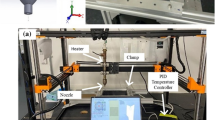Abstract
Incremental sheet forming (ISF), a flexible forming process of rapid prototyping, enables complex shapes to be produced without dedicated dies and suits for small-batch production with short lead time. Support is an important component of incremental forming, which is critical to ensure the geometry precision of parts. However, rigid support is usually adopted which costs much and goes against springback compensation. Thus, in this study, the influence of elastic supports on springback and formability of incremental forming was explored based on numerical simulation and experimental validation. Three kinds of materials (polyurethane material, rubber material, and wood material) were selected to obtain the supports of incremental forming. It was found if a same tool path is employed the more elasticity the support has the larger the shape error is. Additionally, a springback compensation method with a rubber support based on the tool path revision was proposed to improve the geometrical accuracy. This strategy makes uses of the significant elastic deformation of the rubber support, and needs no support repair or change especially compared with a multistage process.
Similar content being viewed by others
References
Allwood JM, King GPF, Duflou J (2005) A structured search for applications of the incremental sheet-forming process by product segmentation. P I Mech Eng B-J Eng 219(2):239–244
Jeswiet J, Micari F, Hirt G, Bramley A, Duflou J, Allwood J (2005) Asymmetric single point incremental forming of sheet metal. Cirp Ann-Manuf Techn 54(2):623–649
Hagan E, Jeswiet J (2003) A review of conventional and modern single-point sheet metal forming methods. P I Mech Eng B-J Eng 217(2):213–225
Jackson K, Allwood J (2009) The mechanics of incremental sheet forming. J Mater Process Tech 209(3):1158–1174
Li J, Shen J, Wang B (2013) A multipass incremental sheet forming strategy of a car taillight bracket. Int J Adv Manuf Technol 69(9–12):2229–2236
Ambrogio G, De Napoli L, Filice L, Gagliardi F, Muzzupappa M (2005) Application of Incremental Forming process for high customised medical product manufacturing. J Mater Process Tech 162–163:156–162
Micari F, Ambrogio G, Filice L (2007) Shape and dimensional accuracy in single point incremental forming: state of the art and future trends. J Mater Process Tech 191(1–3):390–395
Bambach M, Taleb Araghi B, Hirt G (2009) Strategies to improve the geometric accuracy in asymmetric single point incremental forming. Prod Eng Res Devel 3(2):145–156
Attanasio A, Ceretti E, Giardini C, Mazzoni L (2008) Asymmetric two points incremental forming: improving surface quality and geometric accuracy by tool path optimization. J Mater Process Tech 197(1):59–67
Li J, Hu J, Pan J, Geng P (2011) Thickness distribution and design of a multi-stage process for sheet metal incremental forming. Int J Adv Manuf Technol 62(9–12):981–988
Skjødt M, Bay N, Endelt B, Ingarao G (2008) Multi stage strategies for single point incremental forming of a cup. Int J Mater Form suppl 1:1199–1202
Li J, Geng P, Shen J (2013) Numerical simulation and experimental investigation of multistage incremental sheet forming. Int J Adv Manuf Technol 68(9–12):2637–2644
Yang DY, Kim TJ (2000) Improvement of formability for the incremental sheet metal forming process. Int J Mech Sci 42(7):1271–1286
Zhu H, Liu Z, Fu J (2011) Spiral tool-path generation with constant scallop height for sheet metal CNC incremental forming. Int J Adv Manuf Technol 54(9–12):911–919
Han F, Mo J (2008) Numerical simulation and experimental investigation of incremental sheet forming process. J Cent South Univ Technol 15(5):581–587
Ma L, Mo J (2008) Three-dimensional finite element method simulation of sheet metal single-point incremental forming and the deformation pattern analysis. P I Mech Eng B-J Eng 222(3):373–380
Costantino I, Ambrogio G, De Napoli L, Filice L, Fratini L, Muzzupappa M (2004) Influence of some relevant process parameters on the dimensional accuracy in incremental forming: a numerical and experimental investigation. J Mater Process Tech 153–154:501–507
Fu Z, Mo J, Han F, Gong P (2013) Tool path correction algorithm for single-point incremental forming of sheet metal. Int J Adv Manuf Technol 64(9–12):1239–1248
Ambrogio G, Filice L, Gagliardi F (2012) Improving industrial suitability of incremental sheet forming process. Int J Adv Manuf Technol 58(9–12):941–947
Author information
Authors and Affiliations
Corresponding author
Rights and permissions
About this article
Cite this article
Li, J., Bai, T. & Zhou, Z. Numerical simulation and experimental investigation of incremental sheet forming with an elastic support. Int J Adv Manuf Technol 74, 1649–1654 (2014). https://doi.org/10.1007/s00170-014-6117-8
Received:
Accepted:
Published:
Issue Date:
DOI: https://doi.org/10.1007/s00170-014-6117-8




